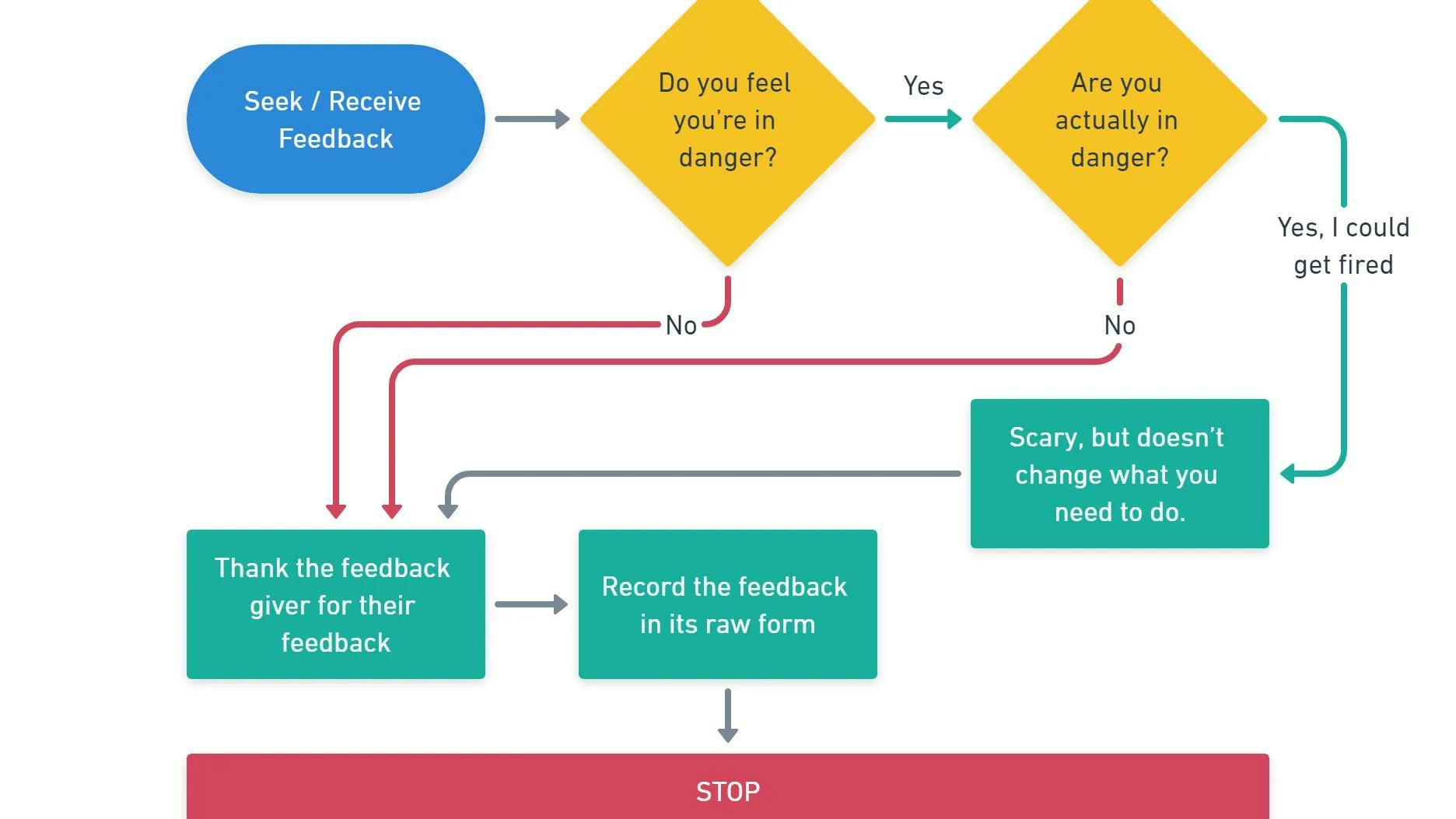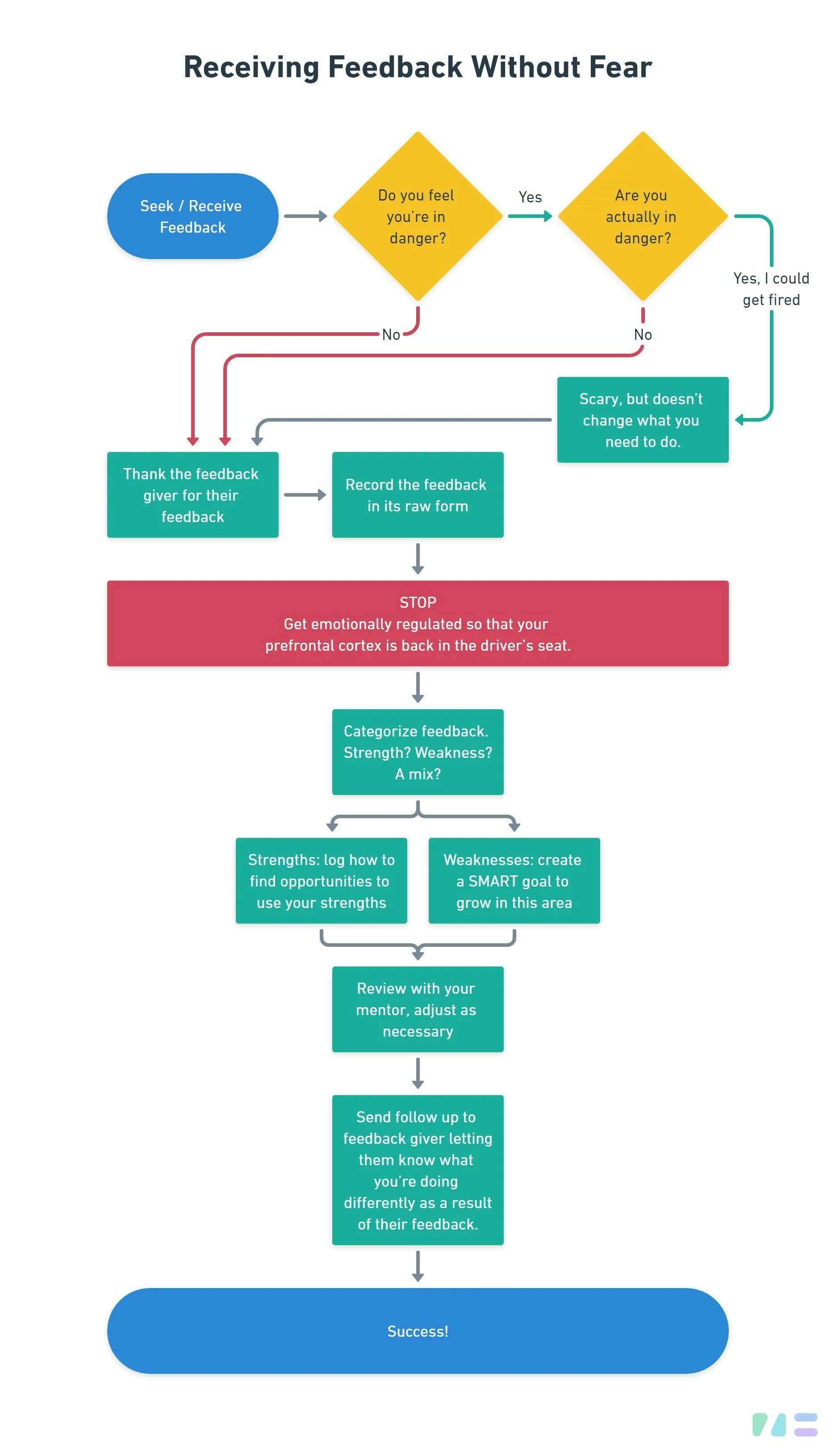
Receiving Feedback Without Fear
Receiving Feedback Without Fear
Receiving feedback can be a very scary thing. When social creatures like us get called out, it can activate deep wiring in our brains that makes us feel unsafe. It would feel more comfortable to avoid feedback altogether. The only problem is that feedback is the main source of growth for designers.
The main reason why we feel fear when receiving feedback is because we are fully identified with our job performance. When someone complements our work, it feels like they are validating our existence as humans. When they critique our work, it feels like they're attacking our very identity.
Until you achieve a state of enlightened non-attachment regarding your job performance, I will show you how to receive feedback fearlessly so that you can use it to foster growth.
The Flow
If you're like me and love the expressive clarity of a task flow, here you go. The wordier version continues below.

Setting Expectations
Feedback can come in many forms; it can come from peers in design critique, managers in performance reviews, users from user research. It can be solicited or unsolicited. While I would like to promise you that feedback will always be well-intentioned, constructive, and empathetically delivered, you know as well as I that we don't live in that world.
The first step to reducing your fear is to have your expectations set accurately. Don't expect that feedback will always be delivered empathetically. By all means, set healthy boundaries and communicate your needs to managers and peers. But don't always expect your preferences to respected. Per Sean Webb, the extent to which your expectations or preferences matches your perception of reality dictates the severity of your emotional reaction. In short, the more respectful you expect everyone to be, the more surprised, angry, and fearful you'll be when they aren't.
When you accept that people will most likely deliver feedback without considering how it might make you feel, you will feel neutral, or pleasantly surprised by those rare moments when people do a great job.
Step 1. How to Receive Feedback
You won't always be able to prepare ahead of time, so it's a good idea to rehearse this process in a safe environment with feedback you have specifically sought out. Ask a mentor or safe peer if they'd be willing to give you some constructive feedback about how you can improve in an area you feel you can be reasonably objective about.
Step 2. What to Do While Listening
While you are listening to what the feedback giver is telling you, there are probably alarm bells going off in your head. You might be hearing an internal monologue that goes something like this: "Oh no! Someone has noticed me performing inadequately. Am I a worthless person? Am I going to get fired? Does everyone hate me? Will I get cast out of the tribe?" ...and so on.
Remind yourself that you are not in any actual danger. The worst thing that can happen is that you will lose your job, and then you'll find another one. Not great, but not the actual end of the world. What's more: the chances are very good that you're blowing this out of proportion in your own mind.
There are only 2 things you need to do when receiving feedback:
- Thank the giver for their feedback — you might not feel like it right now, but do it anyway. It sends a signal to the giver that it's safe for them to give you feedback, which means they'll continue to provide you with opportunities for growth.
- Record the feedback they're giving you in raw form — grab a pen and paper, use a notes app on your phone, or ask if you can record it. Just capture it for processing later. A hidden advantage to writing it down is it gives you something to distract yourself from how uncomfortable it is to have someone point out your flaws. This also gives you an opportunity to ask for clarification if you're having trouble capturing the essence of the feedback in note form.
Here's an example of what you can say if you're the type to freeze when receiving unsolicited feedback.
Thank you for that feedback. I'm going to write it down so I don't forget. You've given me a lot to think about.
You DO NOT need to respond in detail during that moment, or come up with a plan on the spot. In fact, you should avoid doing that until you are sure you've attained emotional balance.
Step 3. Emotionally Regulate
Your limbic system is responsible for emotional reactions, like the fight-flight-freeze reaction you may experience when receiving feedback. When this system is active, it shuts down your prefrontal cortex's ability to reason. This is a terrible place to be communicating or making plans from.
Once you record the feedback and thank the giver, then give yourself a break. Get emotionally stable, however you like to do that.
Personally, I find it helpful to take a walk while acknowledging how I'm feeling. It's a lot easier to let go of the bad feelings when you acknowledge them rather than suppress them. YMMV.
Once you feel balanced again, then proceed to the next step.
Step 4. Process Feedback
Now that you're in a stable place, it's time to dig through the feedback for the valuable parts and discard the rest. Be honest with yourself, and only discard things that are not applicable. If you're not emotionally regulated, you may feel that none of the feedback is applicable, but is probably not true.
Categorize each piece of feedback as either a strength or growth opportunity. If someone has given you positive feedback highlighting a strength, do not discard it.
This may not apply to you, in which case skip to the next paragraph. If you're the type of person who downplays positive feedback however, pay attention. For many years I would discard positive feedback due to a deep-seated fear of standing out, which is linked to my childhood. As a result, I had a very hard time forming an accurate picture of my strengths, and didn't know how to put myself in positions where my strengths were an asset. I also felt I was much worse at my job than I actually was, since I chose to only focus on my weaknesses. Don't do that, please. It's dumb. Instead, record positive feedback in a list you keep. You don't have to look at the list, or even believe it, but eventually the evidence will be hard to ignore and you'll trick yourself into feeling better about your performance.
If someone gives you feedback about a weakness, then do your best to skip the self-pity phase and get right into the designer's problem-solving mindset. Start with the assumption that you can improve, then think about what opportunities you could manufacture for yourself to learn. Pick opportunities that are attainable quickly so you can feel a sense of progress as soon as possible.
This is where SMART goals are extremely helpful. Avoid goals like "get better at selling design to stakeholders." A better goal would be "Practice selling design to stakeholders twice a month, and ask manager for feedback on my performance."
Step 5. Review With a Mentor
This is a perfect topic to bring up with a mentor. Discuss the feedback you received, and why you received it. Share how it made you feel. But more importantly, share what you plan on doing about it.
This is a good opportunity to reduce unknown unknowns. Ask your mentor what they would do about the feedback, and if they have any ideas for improvement that you haven't considered.
Step 6. Follow Up With Feedback Giver
Depending on who gave the feedback and how poorly they delivered it, this may be a very hard step. But it's an important one.
While it may feel like the person giving the feedback was trying to insult you, or make you feel bad, or make you look bad in front of the boss, what they actually did was give you a gift. It can be a hard gift to receive, but it's a valuable one.
So thank them for their gift. Let me know that it was helpful to hear and what you're doing to grow through it. If the person was indeed trying to insult you, I guarantee this will catch them off guard in an exquisite way.
This also signals to the giver that you are a safe person to deliver feedback to, which will encourage them to give you more gifts of feedback in the future. This lets you accelerate your growth.
It Gets Easier Over Time
The more you practice this process, the easier it gets. Eventually, you'll be able to separate your job performance from your identity entirely so you can look at it objectively. The more you practice receiving feedback well, the faster you'll grow and the easier it will be to receive. It's a virtuous cycle that will lead you to growth.